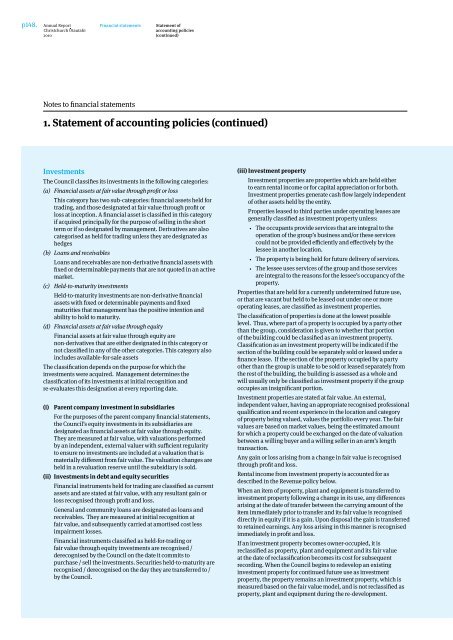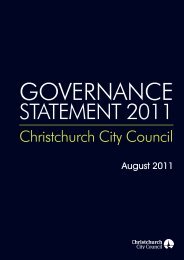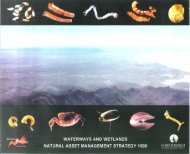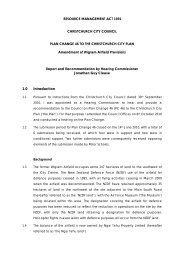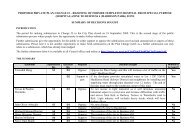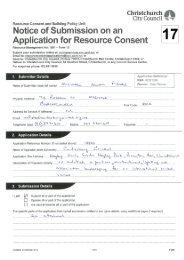Annual Report 2010 - Christchurch City Council
Annual Report 2010 - Christchurch City Council
Annual Report 2010 - Christchurch City Council
You also want an ePaper? Increase the reach of your titles
YUMPU automatically turns print PDFs into web optimized ePapers that Google loves.
p148.<br />
<strong>Annual</strong> <strong>Report</strong><br />
<strong>Christchurch</strong> Otautahi<br />
<strong>2010</strong><br />
Financial statements<br />
Statement of<br />
accounting policies<br />
(continued)<br />
Notes to financial statements<br />
1. Statement of accounting policies (continued)<br />
Investments<br />
The <strong>Council</strong> classifies its investments in the following categories:<br />
(a) Financial assets at fair value through profit or loss<br />
This category has two sub-categories: financial assets held for<br />
trading, and those designated at fair value through profit or<br />
loss at inception. A financial asset is classified in this category<br />
if acquired principally for the purpose of selling in the short<br />
term or if so designated by management. Derivatives are also<br />
categorised as held for trading unless they are designated as<br />
hedges<br />
(b) Loans and receivables<br />
Loans and receivables are non-derivative financial assets with<br />
fixed or determinable payments that are not quoted in an active<br />
market.<br />
(c) Held-to-maturity investments<br />
Held-to-maturity investments are non-derivative financial<br />
assets with fixed or determinable payments and fixed<br />
maturities that management has the positive intention and<br />
ability to hold to maturity.<br />
(d) Financial assets at fair value through equity<br />
Financial assets at fair value through equity are<br />
non-derivatives that are either designated in this category or<br />
not classified in any of the other categories. This category also<br />
includes available-for-sale assets<br />
The classification depends on the purpose for which the<br />
investments were acquired. Management determines the<br />
classification of its investments at initial recognition and<br />
re-evaluates this designation at every reporting date.<br />
(i) Parent company investment in subsidiaries<br />
For the purposes of the parent company financial statements,<br />
the <strong>Council</strong>’s equity investments in its subsidiaries are<br />
designated as financial assets at fair value through equity.<br />
They are measured at fair value, with valuations performed<br />
by an independent, external valuer with sufficient regularity<br />
to ensure no investments are included at a valuation that is<br />
materially different from fair value. The valuation changes are<br />
held in a revaluation reserve until the subsidiary is sold.<br />
(ii) Investments in debt and equity securities<br />
Financial instruments held for trading are classified as current<br />
assets and are stated at fair value, with any resultant gain or<br />
loss recognised through profit and loss.<br />
General and community loans are designated as loans and<br />
receivables. They are measured at initial recognition at<br />
fair value, and subsequently carried at amortised cost less<br />
impairment losses.<br />
Financial instruments classified as held-for-trading or<br />
fair value through equity investments are recognised /<br />
derecognised by the <strong>Council</strong> on the date it commits to<br />
purchase / sell the investments. Securities held-to-maturity are<br />
recognised / derecognised on the day they are transferred to /<br />
by the <strong>Council</strong>.<br />
(iii) Investment property<br />
Investment properties are properties which are held either<br />
to earn rental income or for capital appreciation or for both.<br />
Investment properties generate cash flow largely independent<br />
of other assets held by the entity.<br />
Properties leased to third parties under operating leases are<br />
generally classified as investment property unless:<br />
• The occupants provide services that are integral to the<br />
operation of the group’s business and/or these services<br />
could not be provided efficiently and effectively by the<br />
lessee in another location.<br />
• The property is being held for future delivery of services.<br />
• The lessee uses services of the group and those services<br />
are integral to the reasons for the lessee’s occupancy of the<br />
property.<br />
Properties that are held for a currently undetermined future use,<br />
or that are vacant but held to be leased out under one or more<br />
operating leases, are classified as investment properties.<br />
The classification of properties is done at the lowest possible<br />
level. Thus, where part of a property is occupied by a party other<br />
than the group, consideration is given to whether that portion<br />
of the building could be classified as an investment property.<br />
Classification as an investment property will be indicated if the<br />
section of the building could be separately sold or leased under a<br />
finance lease. If the section of the property occupied by a party<br />
other than the group is unable to be sold or leased separately from<br />
the rest of the building, the building is assessed as a whole and<br />
will usually only be classified as investment property if the group<br />
occupies an insignificant portion.<br />
Investment properties are stated at fair value. An external,<br />
independent valuer, having an appropriate recognised professional<br />
qualification and recent experience in the location and category<br />
of property being valued, values the portfolio every year. The fair<br />
values are based on market values, being the estimated amount<br />
for which a property could be exchanged on the date of valuation<br />
between a willing buyer and a willing seller in an arm’s length<br />
transaction.<br />
Any gain or loss arising from a change in fair value is recognised<br />
through profit and loss.<br />
Rental income from investment property is accounted for as<br />
described in the Revenue policy below.<br />
When an item of property, plant and equipment is transferred to<br />
investment property following a change in its use, any differences<br />
arising at the date of transfer between the carrying amount of the<br />
item immediately prior to transfer and its fair value is recognised<br />
directly in equity if it is a gain. Upon disposal the gain is transferred<br />
to retained earnings. Any loss arising in this manner is recognised<br />
immediately in profit and loss.<br />
If an investment property becomes owner-occupied, it is<br />
reclassified as property, plant and equipment and its fair value<br />
at the date of reclassification becomes its cost for subsequent<br />
recording. When the <strong>Council</strong> begins to redevelop an existing<br />
investment property for continued future use as investment<br />
property, the property remains an investment property, which is<br />
measured based on the fair value model, and is not reclassified as<br />
property, plant and equipment during the re-development.


